A Swiss digital healthcare system: What the population thinks
A Swiss digital healthcare system: What the population thinks unknown
Executive Summary
Switzerland is recognised as one of the most innovative countries in the world. In the IMD World Digital Competitiveness (WDC) ranking 2022, Switzerland ranks fifth (2021: sixth place) (IMD World Competitiveness Center, 2022). Digitalisation has picked up speed in Switzerland’s industries, such as the banking sector, which is now almost fully digitalised. One sector is still lagging far behind: healthcare. This topic has been the focus of multiple actors from the public and private sector for many years. Until now, the digital transformation has not been successful. We are still years behind European countries such as Denmark or Estonia, which have fully digital healthcare systems.
The different actors of the healthcare ecosystem have spent a lot of time and effort in establishing the best technology to support this change. Many solutions and initiatives around this topic are present today. The electronic patient record (EPR) was developed. New digital health platforms were created recently through collaborative consortiums.
To be effective, digital tools are developed and tested with end users to ensure that tools are performing as effectively as possible. If they do not meet the needs of end users, they will not be adopted. Therefore, the digital healthcare platform/solution should be developed with its end users, the citizens of Switzerland.
With this publication, we wanted to give the Swiss population the opportunity to express their desires and concerns regarding the digitalisation of the healthcare system. This was achieved through a survey, conducted at the end of summer 2022.
With this survey, the citizens’ perspective on the topic can be grasped more accurately. We can clearly see the willingness of the Swiss population to use a digital healthcare system, provided it offers clear added value such as better usability, improved diagnosis and treatments and lower healthcare costs.
The survey reveals that many Swiss citizens rate their health literacy (76%) and digital literacy (72%) as high to very high. Health literacy increases with age, whereas digital literacy decreases. The level of education also plays a key role, as people with a higher level of education have higher health and digital literacy.
Another key finding is around the trust in different organisations handling health data. 70% of respondents have a high to very high level of trust in health providers (including hospitals) followed by the government (47%), while the private sector (22%) enjoys the lowest level of trust. Trust in hospitals and general practitioners also justifies their high status as being the most important source of health information (54%). Medical staff have been a central element of the health system for centuries, but there are signs of a shift towards a system that is less focused on medical professionals and more on patients.
Simultaneously, the role of the patient is also evolving as they are taking a more active role and more personal responsibility than in the past. Thus, 31% of the population no longer refer exclusively to people in need of treatment as patients. Everyone is a patient, whether healthy, ill or injured. This is also reflected in the increasing diversity of prevention services offered by health insurance companies. Tomorrow’s health system should be patient-centric and enable patients to inform themselves about their health and to engage more with preventive measures. This is with the aim of promoting a more active and healthier society.
This goes well with patients’ desire to have more control over their own health data. 68% of the population want to be the rightful owners of their personal health data. The electronic health record is a step in this direction, as patients themselves have control over who can access their data.
Digitalisation has many advantages, but it also arouses fears among citizens. 46% of the respondents fear that their data will be misused or stolen. Data protection has recently become more of a focus, but must play an even more central role in the digitalisation of healthcare in the future to ensure that appropriate systems and solutions are used to store and exchange data as well as to avoid data misuse, incorrect storage or data theft.
Only with a collaborative approach from all the healthcare players (including patients) will it be possible to advance the healthcare system into the digital space and bring about a change in awareness among the population.
Survey Method
The survey was conducted in a representative random sample (n= 1110) of the Swiss population. The population was contacted via an online panel between 1st and 14th September 2022. An independent research organisation (gfs-zürich) was commissioned to conduct the survey. The participation was anonymous and voluntary. The demographic composition of the interviewed participants from the population was specifically constructed to be representative of the 18+-year-old French-, German- and Italian-speaking population of Switzerland, according to the quota features gender, age and language region. Ticino was slightly over-proportionally surveyed to allow for individual assessments. To obtain the overall results the sample was weighted according to language regions.
Percentages are always rounded to a whole number, averages to a decimal. Percentages <1 per cent are partly visible in the graphs through colours, but are not labelled.
Chapter 1: Health Status
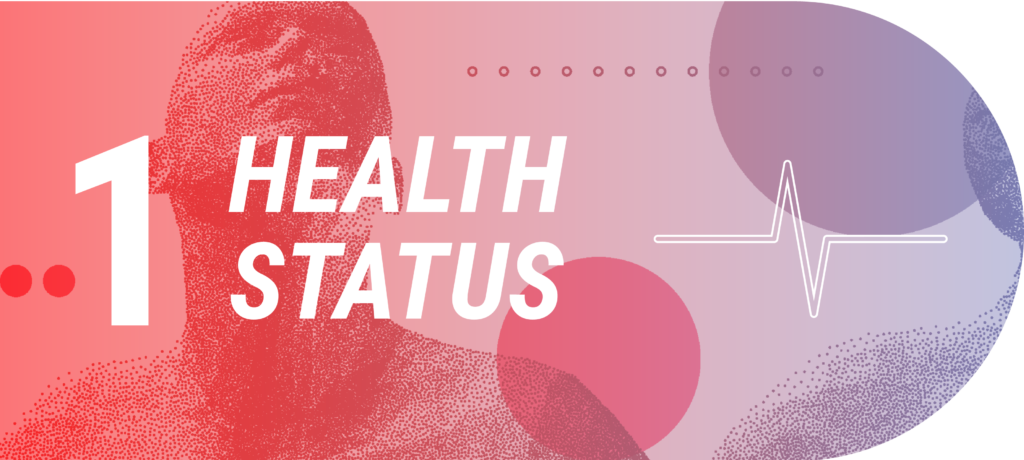
1.1 Health state information
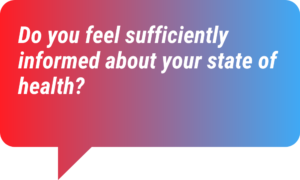
In the 2018 report from the Euro Health Consumer Index (EHCI), Switzerland was ranked as having the best healthcare system in the world (Björnberg & Phang, 2019). The quality of care is very high in Switzerland due to the high density of healthcare professionals (World Health Organisation, 2022) and high ranking universities. Additionally, every citizen living in Switzerland needs compulsory health insurance which allows access to good health services. (Health Insurance, BAG).
In the survey, we asked the population if they felt sufficiently informed about their health. 78% of the respondents felt well to very well informed about their health. The youngest generation (18-39 yrs, 74%) is slightly behind the two older generations (80% and 81%) (Graph 1). This could be due to the fact that the younger generation is “healthier” and therefore less interested in health related topics and their health status.
Interestingly, people who rate themselves as having good to very good digital skills are also more likely to say they are well or very well informed about their health state (82% versus 64%). Digital technology enables people to quickly search and collect all types of information. They can easily access data related to their different health conditions.
No influence could be found between the evaluation of the health information level and the fact whether one suffers from a chronic disease or not.
Digital solutions open up a whole new level of access to information for the citizens. In the future, the population would therefore easily find information regarding their own health and feel even more in control of their wellbeing.
Graph 1 – Information level on health state
The untapped potential of prevention in the Swiss healthcare system – Philomena Colatrella, CSS “We all hope to be spared a serious illness. But how can we maintain our health? And who’s in charge of that? Traditionally, healthcare systems focus on healing people. It therefore comes as no surprise that we’re not exploiting the full potential of prevention. Especially when it comes to widely spread non-communicable diseases such as diabetes or cardiovascular problems. Studies have shown that behaviour has a much greater impact than factors such as genetics, the environment or even access to healthcare. And there are so many ways to support a healthier lifestyle. Smart watches, fitness trackers and other wearables have reached all segments of our society and can be of great use: by tracking our steps and motivating us to move more. By supporting us in making better choices when it comes to our nutrition. Prevention can come in very different forms. As a health insurer, we offer financial incentives for those who commit to behaving in a healthier manner – a strictly voluntary proposition which is very well accepted. It is by integrating new forms that we can make prevention more effective. It is time to pursue this goal by all available means.” |
1.2 Sources of health information in Switzerland
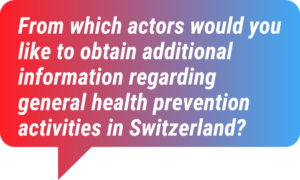
Today’s healthcare system is focused mainly on diagnosing and treating ill and injured patients. As the population is ageing, this makes Switzerland’s healthcare costs extremely high, leading to a total of CHF 83.3 billion per year in 2020 (Swiss Confederation – BFS, 2022). The system is slowly shifting towards a system focused more on prevention and keeping “patients” healthy for a longer period. This will help to decrease the costs and enhance the quality of life.
Switzerland has many different actors playing different roles in the healthcare system. We were curious to better understand who the population would turn to for additional information regarding prevention activities.
Graph 2a shows that medical staff remain the main source of information for the Swiss population as a whole, regardless of the sex of the respondents (54%). Insurance companies come in second position, with a significantly higher proportion of males wanting to be informed by providers (43% versus 35%). Males also look more to the government to provide information (29% versus 18% for females).
Graph 2b shows the difference in distribution according to the generation of respondents. The older generation is more inclined to seek additional information from medical staff (60%) and less from insurance providers (32%) versus 18-39 yrs: 44% and 40-64 yrs: 39%. The youngest generation turns more to the government (26%) and strongly believes in the importance of education for the dissemination of information on health prevention (43% versus 15% and 5% for the older generations).
Medical staff have been at the centre of the healthcare system for centuries and therefore identified as the main source of information relating to healthcare data. Today’s healthcare system is slowly shifting towards a system less evolving around the medical professions and more around the patient.
Medical professionals still have the most important role to play in healthcare in the eyes of patients, especially the older generation. The healthcare system is currently shifting towards a network model, where each actor plays a specific role to enable a successful outcome (medical staff, insurances, government etc.).
People who self-assess their health state as rather poor or patients suffering from chronic diseases are more likely to seek information on health activities from general practitioners (both 65%). They may not feel empowered about their health and seek guidance from their closest ally: their doctor.
Health insurers play an important role in the preventive activities in the Swiss healthcare system as stated in Article 19 and Article 26 of the Federal law on health insurance (KVG/LAMal, 1994). It is therefore in their duty to promote preventive health activities to keep citizens healthier and premiums as low as possible. Many health insurance companies in Switzerland have developed digital tools to help customers follow a healthy lifestyle and be more self aware. For example, CSS has developed active365, an application which rewards users with valuable points when making positive decisions regarding their nutrition, exercise mindfulness or mental health. Helsana has also developed a similar application, the Helsana+ app, which rewards preventive health measures and interaction with the insurance company.
The younger generation sees high potential for the education system to play a more active role in promoting health prevention activities. Education is mandatory and free for all children in Switzerland for a total of eleven years. (Compulsory Schooling – SWI Swissinfo.ch, 2022). As habits are more easily formed during childhood, it would be a great environment to raise awareness for health prevention measures and activities to ensure that all citizens have access to the same initial level of information and can live equally healthy lifestyles.
Promotion of preventive health activities leading to healthier lifestyles will be the baseline of the healthcare system of tomorrow. Only if each actor of the healthcare network plays a role in the system will this be feasible. Digital tools such as apps or wearables can help citizens track their habits and make positive choices for a healthier life.
Graph 2 – Actors who should share additional information regarding health prevention activities in Switzerland
A. Distribution based on sex
B. Distribution based on age
1.3 Swiss population health status self-assessment
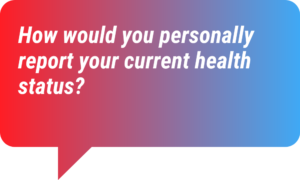
The combination of multiple factors affect the health of individuals. Social, economic and physical environment, as well as individual characteristics and behaviours influence an individual’s health state(World Health Organization, 2017).
In the survey, we asked the interviewees to personally reflect on their current health state. It is important to keep in mind that the time of day and state of mind of the respondent has a direct influence on their self-assessment of personal health.
Almost three quarters of the interviewees rate their own health as good or excellent (74%). The younger generation feels best (79%) and the middle-aged generation feels worst (71%), which is still a high level.
When comparing the purchasing power of the respondents, it is interesting to see a correlation between the level of wealth and the person’s health state. The wealthy group has the highest self-assessed health state (86%), whereas the group with the lowest purchasing power reports the lowest health state (61%).
Interviewees who rank their health and digital capabilities highly feel in better shape than people who don’t (78% versus 60%).
Switzerland is a very wealthy country, ranking 3rd in the United Nations Index (UNECE, 2020) and offering a great standard of living. This explains partially the high rate of personal health evaluation from the respondents. The level of wealth is directly linked to the health status, as it impacts the conditions under which one can afford to live.
Digitalisation enables easy access to health related information and has a direct impact on an individual’s health state as they feel they have more control (Ward, 2013). They have access to a pool of knowledge at their fingertips.
Graph 3 – Swiss population’s health status self-assessment
Chapter 2: The Patient
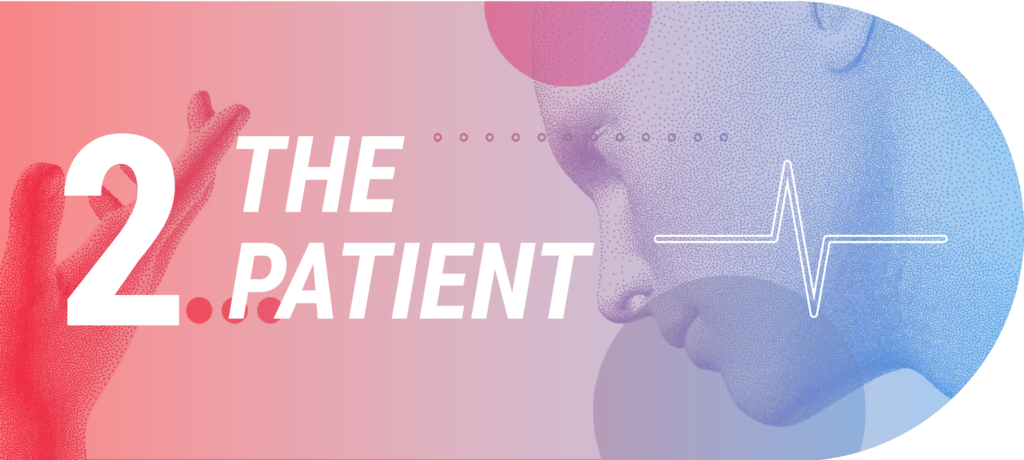
2.1 Who are “patients”
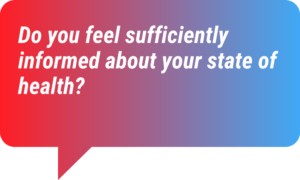
The term patient comes from the Latin “pati-” to suffer, to endure, to bear (Neuberger, 1999). Throughout time and amongst differences in cultures, its definition has evolved and been adapted multiple times, giving the patient a passive role of enduring pain quietly and awaiting medical care. Nowadays people use the word patient to define many different personas, which we could often replace with synonyms such as “client”, “consumer”, “user” and “customer” of the healthcare system (Deber, 2005). The relationship between the patient and the healthcare provider has also evolved. The patient is not seen as a passive player any longer. They take a more active role and are equal to their professional adviser who gives them medical guidance (Neuberger, 1999). Patients have more recently been defined as individuals who interact with a clinician, either for an actual or perceived illness or for health promotion and disease prevention, therefore the patient no longer needs to be ill or injured (Institute of Medicine, 1994).
In the survey, we asked the population who they considered to be a patient. 68% of the overall population still define a patient as a person who needs medical consultation, diagnosis or treatment, whereas only 31% of people refer to everyone as a patient, whether healthy, ill or injured.
In Graph 4 (see page 7) we identify a significant difference in perception of patients within the different age groups. The younger the interviewee, the more likely they are to understand the term “patient” as meaning any individual. This might indicate that younger (and often still healthy) generations see themselves as both healthy and being a “patient” in the sense of a healthcare consumer taking action for their wellbeing and health status.
We are all affected by our health on a daily basis and are therefore all “patients”. The healthcare system of tomorrow should be patient-centric, empowering the patient to be informed about their health, focusing more on prevention activities in order for citizens to take more action and stay healthy longer. This will decrease the costs and increase the citizens’ wellbeing.
Graph 4 – Population’s perception of the term “patient” based on age group
Graph 5 – Occurrence of chronic disease in the Swiss population
| Being a “patient” in Switzerland and their future desired role – Susanne Gedamke, Swiss Patient Organisation “The whole health care system talks about patient-centeredness. But how patient-centered is our healthcare system really? One thing is clear: We don’t even know. Because patients are not asked. All parameters in the healthcare system are based on professional criteria. But shouldn’t a healthcare system be primarily oriented toward the users of the system, the patients, the people? It is time that the needs of patients are determined reliably and differentiated and that resources of patients are included in the decision-making process. After all, in a high-quality health care system, it is not only the professional perspective that counts, but also the perspective of those affected.” |
2.2 Chronic diseases
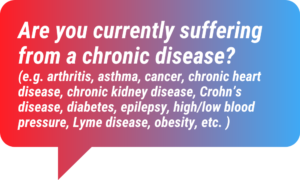
Chronic diseases, also known as non-communicable diseases (NCDs), are a result of a combination of genetic, physiological, environmental and behavioural factors and last for a year or more (About Chronic Diseases, 2022). The main types of chronic diseases are cardiovascular diseases, chronic respiratory diseases, cancer and diabetes, but there are other, less common NCDs.
One third of the interviewed citizens (33%) state that they are currently suffering from a chronic disease (see Graph 5, page 7). The older the interviewees are, the more likely they are to suffer from a chronic disease. One in two citizens above the age of 65 is affected by a NCD ( 49%). This is due to the fact that through the ageing process, multiple molecular and cellular event malfunctions occur, ultimately leading to various chronic ailments and diseases, including neurologic disorders, cardiovascular diseases, macular degeneration and diabetes. These chronic diseases usually occur in the middle/later age after a long exposure to specific features and an unhealthy lifestyle (lack of physical activity, high-fat diet, stress, alcohol and tobacco intake) (Prasad et al., 2012).
We also observe that people with a low purchasing power are more likely to state that they are suffering from a chronic disease (43%). This could be due to the fact that due to their lower income, they are not able to afford the best health services and nutrition sources (Kim et al., 2016), which leads to unhealthy lifestyle choices, and thus to chronic diseases.
Fortunately, chronic diseases are well treated in Switzerland today and “patients” can monitor their symptoms and lead a healthy life. This is seen in the survey as interviewees suffering from NCDs do not assess their health status to be lower than other interviewees.
In the future healthcare system of Switzerland, we should do more prevention promotion in order for citizens to follow healthy lifestyles and decrease their chances of developing a chronic disease. Tracking health data can support positive habits and enable citizens to live healthier lives.
Chapter 3: Health & Digital Literacy in Switzerland
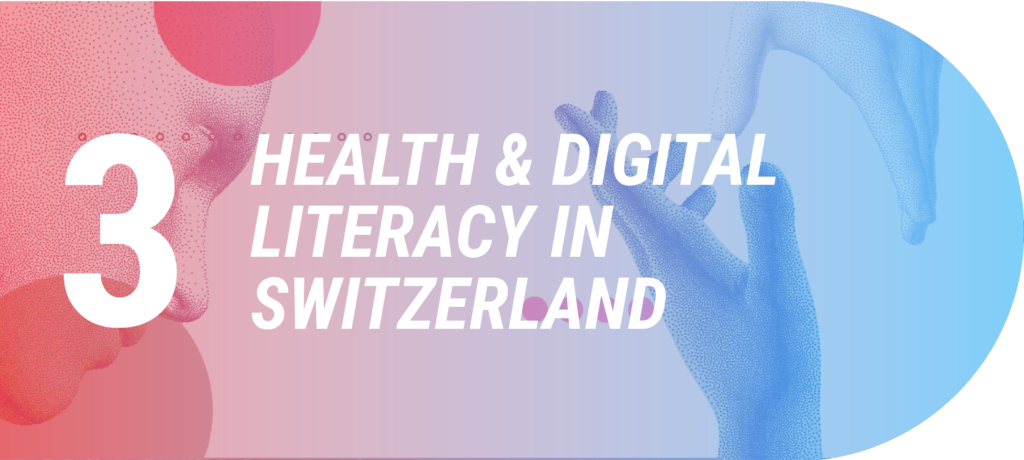
3.1 Health literacy
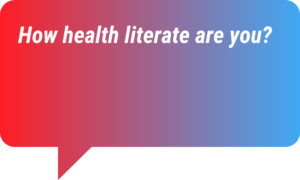
Personal health literacy is the degree to which individuals have the ability to find, understand and use information and services to inform health-related decisions and actions for themselves and others (HRSA, 2022). This was the selected definition which was used in our survey.
Three quarters of respondents evaluate themselves as having high to very high health literacy levels (76%).
As identified on Graph 6, there is a significant correlation between the age of the interviewees and their level of health knowledge. The older generation has the highest health literacy (82% versus 71% for the younger generation). This can be explained by the fact that the older you become, the more interested you are in your health and in topics related to it, as your health is slowly decreasing.
There is also a correlation between the level of education and the level of health knowledge. The higher a person’s level of education, the more likely they are to have high levels of health literacy (79% versus 62% for low level of education). It is therefore important to include health topics in the school curriculum as education is compulsory for everyone up to eleven years (from the age of 4 until the age of 15) .
The French-speaking region of Switzerland is less health literate as the German- and Italian-speaking regions (W-CH: 61% versus D-CH: 77% and I-CH: 73% ranked 4-5 to the question). These differences between the regions might be explained by differences at the cantonal level. This emphasises the importance to focus on improving health literacy, not only at a national level but also at a regional or cantonal level. Especially in a country as decentralised as Switzerland (Guggiari et al., 2021).
Careum Foundation, working towards promoting healthcare education, worked on a two-year study project (2019-2021) to compare the health literacy of 17 different European countries. It was identified that Switzerland performed below average in comparison to other countries (De Gani et al., 2021). This shows that even if health literacy levels are high in Switzerland, there is still much improvement required at a cantonal, regional and national level for Switzerland to reach the level of other European countries such as Denmark.
| Importance of health literacy in Switzerland – Alexandros Giannakis, Accenture “Switzerland is a country where increasing health literacy can be more effective than normal in terms of impact: 🔹 People have access to information, and to communication channels across the country, and more than an average country 🔹 People have the necessary means to access health advice, be it in the form of better nutrition, or in the form of accessing and using fitness and/or wellbeing services, etc. 🔹 Switzerland, especially in rural areas, is made up of small, tightly-knit communities. When reaching a certain scale of health literacy within a given community, then the impact and effect can scale across the whole, or bigger parts of the community, meaning the ROI of health literacy can be even more effective than normal In view of these positive factors, health literacy should be strengthened throughout the country and especially in rural areas, where certain aspects of health and a healthy lifestyle (e.g. nutrition), can be significantly improved. Tobacco consumption, on the other hand, is statistically higher in Switzerland than in other high-income countries, as the statistics of recent decades show. With health insurers having the means to push for health literacy campaigns and initiatives, this is providing a very sound setup for a country where health literacy can be pursued and improved drastically.” |
Graph 6 – Health literacy in Switzerland
Graph 7 – Digital literacy in Switzerland
3.2 Digital literacy
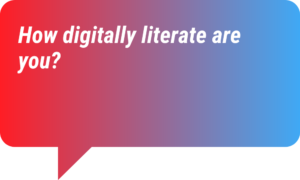
Digital literacy refers to the ability to use information and communication technologies to find, evaluate, create, and communicate information, requiring both cognitive and technical skills (ALA, 2011). This was the selected definition which was used in our survey.
Almost three quarters of the respondents estimate that their digital competences are high to very high (72%).
There is a significant correlation between the age and the education level of respondents and their perceived digital skills. The younger the interviewees are, the more digital savvy they assess themselves to be (61% for the 65+ yrs, 74% for the 40-64 yrs and 78% for the 18-39 yrs).
Digitalisation essentially started in the 1950s with the advent of computers but only made its disruptive arrival in the 1990s with the advent of the Web (Press, 2015). Therefore older generations did not grow up with digitalisation and had to upskill at a later stage, whereas younger generations were born with the internet and grew up using digital tools. The pandemic had a very positive impact on digital technologies as the older generation needed to use them to communicate with their families and friends and therefore 74% of the older generation used the internet (Rubín et al., 2020). The more educated the interviewees are, the more digital literate they are (low: 53%, middle: 70% , high: 85%).
This can be explained as the further you study, the more you are confronted with the digital word and digital tools. Switzerland has one of the highest-ranked educational systems in the world which includes excellent work opportunities and is starting to incorporate digital knowledge and computer science into the school curriculum (Robert).
One in two respondents corresponding to the wealthy purchasing power category rate their digital skills as very good (scale 5: 55%).
The majority of the stakeholders of the wealthy purchasing power group rate have corporate professions, which require the daily use of computers and other technologies.
People who are mostly unconcerned about digitalisation more often indicate high digital literacy (82% versus 70% for very concerned respondents). This could be explained by the fact that stakeholders who are more concerned by digitalisation tend to be more cautious of using digital tools and therefore less digital literate.
Digital literacy in Switzerland has increased extensively over the past years and has taken a step towards a sustainable development (Swiss Confederation – BFS, 2021). But it still requires a fast upgrade to keep up with the change rate and avoid a digital divide, leaving out a part of the population in the digital transformation.
3.3 Interconnection between health and digital literacy
Health and digital literacy levels in Switzerland are highly ranked overall. There is a strong correlation between both. People that highly rate their health literacy have a higher tendency to have high digital literacy levels as well (83%) and vice-versa (79%). Respondents who self-assess their health state highly are more likely to have high digital competencies (79%) in comparison with the ones who rated it low (55%). Nowadays information is mostly accessible through the internet and therefore it is logical that people with higher digital literacy are most likely to have better access to health information and have a better literacy in that domain. This leads to better health conditions.
These two competences are now also summarised under the new term digital health literacy. It is defined by Careum Foundation as the degree to which individuals are able to obtain, understand and judge health information from digital sources and use it to make decisions about their health (De Gani et al., 2021). If these levels are low, it will lead to negative consequences such as increased health inequities in a world where healthcare is being digitised. Patients who are not capable of using digital tools or don’t see their importance or cannot access them will not have access to their benefit and give them a clear disadvantage for their health improvement and engagement (Heath, 2022).
We need to act quickly to ensure no one is left behind. We need to prepare the users for a healthcare system which continuously integrates new ways to engage the patient with technologies and therefore find new strategies to improve the level of digital literacy in Switzerland.
Chapter 4: Digital Habits
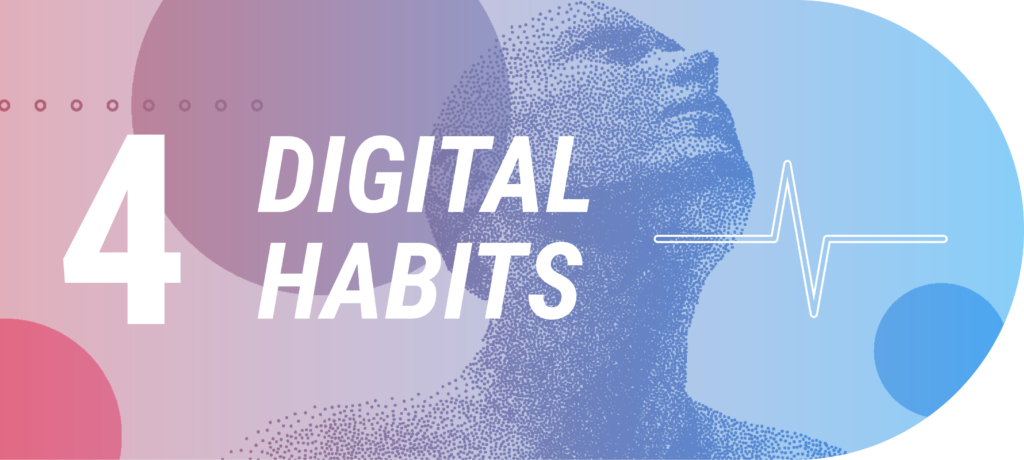
4.1 Time spent on digital tools

At the beginning of 2022, the Swiss population counted 8.74 million (Worldometer), with 8.57 million internet users representing 98% of the population (Kemp, 2022). Digitalisation is therefore more present than ever in this central European country.
In the survey, we wanted to better understand the average time spent on digital devices, including their time at work. The findings were well distributed with nearly a third (29%) indicating a duration of use of up to 3 hours, another third between 3 and 6 hours (32%) and 36% using it daily more than 6 hours.
The younger respondents are the ones who spend more time on digital tools (18-39 yrs: 55%, 39-64 yrs: 41% and 65+yrs: 10% spent above 6h). This can be partially explained by the fact that during your employment age, you are often using computers daily for your professional occupation. The older population who are more commonly retired, do not need to use digital tools as often as they do not need them for their professions. In Switzerland, the retirement age is 64 for women and 65 for men, but people can also retire earlier if they have the financial possibility (Swiss Confederation). On the other hand, the young generation spends more of their free time on devices than the older population (average of 4 hours) versus 2.5 hours for the middle aged population (Swissinfo, 2019).
The higher the purchasing power category, the longer time spent per day on digital devices (48% of the wealthy purchasing power category spend more than 6 hours on their digital tools). People with more financial means are more inclined to have professions requiring more screen time and technologies, and this in addition to their free time digital leisure would add up and increase their overall average time spent on their computers, tablets or smartphones.
As seen above, the Swiss population is accustomed to using digital tools for work and leisure on a daily basis and could therefore easily become comfortable using it as well to track their health data and wellbeing.
Graph 8 – Time spent on digital tools
Graph 9 – Health data tracked on digital tools
4.2 Health data tracked on digital tools
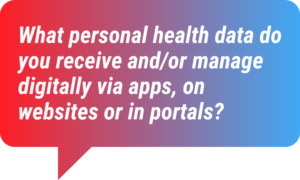
92% of the Swiss population uses a smartphone in 2022 (O’Dea, 2020). Smartphones contain internal or external applications which often track health data continuously. While some data is collected without the knowledge of individuals (e.g. steps) other data is collected on a voluntary basis through connected watches, mobile phones and applications.
In the survey, we asked the Swiss population what types of data they monitored with digital tools (Graph 9, page 14). More than half of the Swiss population captures their daily steps (51%) with an even higher proportion in the younger generation (60%).
While certain citizens cautiously track their steps per day with precise gadgets, most of the population still is not aware that their mobile phone tracks such information in the background. As it is often recommended to walk a certain amount per day, these tools help to see progress and how much you need to walk to stay healthy.
Sport activities (32%) and pandemic containment applications come in second place (32% of the population monitors this data) followed by data linked to insurance (29%).
On the contrary, sport related, pandemic data and insurance related data are all tracked on a voluntary basis and therefore often need to be downloaded or connected to additional applications or gadgets to track continuously. The COVID-19 pandemic brought many limitations to the Swiss population which removed certain rights if they did not have the possibility to present certain health data. This increased the uptake of such applications as the citizens wanted to move freely in their towns and continue to live their lives.
After monitoring these health data linked to special needs/rights, citizens track the most specific health-related features such as menstrual cycle by the female population (27%), heart rate (20%) and sleep cycle (20%). These data give you a better understanding of your state of health and help you monitor your health and wellbeing.
Even if a majority of the population tracks at least one type of health data, 21% do not receive/manage any data digitally. This is mostly represented by the older generation which did not grow up with these different tools and which is less inclined to take on new habits of tracking their different health features. They are still used to getting their health values captured only one time a year at their doctor’s visit.
Overall on average, the older the interviewee, the less types of data they manage digitally (18-39 yrs: 3.1, 40-64 yrs: 2.6 and 65+ yrs: 1.7).
In the future of healthcare, monitoring one’s health values at home continuously would enable better health outcomes as the doctor would be able to better understand the evolution of the data through time and ensure the best treatment possible for the patient.
4.3 Frequency of use of digital tools for health tracking
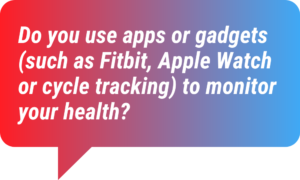
In 2021, 80 million smartwatches were sold, compared to barely 16 million conventional Swiss watches (Müller, 2022). Smartwatches offer additional features as they can directly be synchronised to other devices. Among many functionalities, these devices help to monitor sleep patterns, nutrition, exercise, monitor vital signs or keep track of chronic disease (Schoonbee, 2021). In the survey, we questioned Swiss citizens how often they use such digital tools for health monitoring. More than a quarter (28%) record their health data on a daily basis, while 43% never use such gadgets to monitor their health. This means that a vast majority of the population tracks their health activities on a gadget or application on their smartphone nowadays (Swissinfo, 2018).
As one could expect, the younger the respondents, the more they use apps or gadgets to record their health status (33% of the younger generation record it daily and 19% multiple times a week). This is explained by the fact that millennials and Gen Z are the most receptive to new technologies and new gadgets (Koch, 2018) and are more targeted by such products through social media platforms (sproutsocial). On the contrary, the older generation has a higher tendency to not monitor their health with devices (65% never track any data).
An interesting finding is that people who often use digital tools to monitor their health do not feel more health literate, only more digital literate. This could be due to the fact that many people just want to capture their health data and do not take the time to understand what this data really represents and how they could use them to better understand their health state.
People who are less concerned about digitalisation tend to use such tools on a more regular basis (47% use it on a weekly basis). This is well explained by the fact that stakeholders which are concerned about the implication of digitalisation tend to avoid using digital devices to store/share their health data. They are concerned as they feel they have no control over how their data is being handled.
Smartwatches and smartphones are great digital tools to monitor health data. They should be more used in Switzerland as they allow citizens to capture real time data and have a better understanding of their health. It is a great product in the medical field to enable easy information overview between healthcare professionals and patients (Elnagar et al., 2022). To enable smooth adoption, technology providers should tailor their products to all age groups and clearly explain how health data is being processed and tracked.
| Home monitoring for enhanced health data tracking – Dr. med. Conrad E. Müller FMH, MBA, Pro UKBB Foundation Patient home monitoring avoids hospitalisation During the COVID-19 pandemic, the health care system was under heavy strain. Up to 30% of the hospital capacity was needed for the COVID patients. This resulted in long waiting times for elective treatments and delayed diagnosis and therapy for other conditions with correspondingly negative outcomes. What is Home Monitoring? When patients are cared for at home, their vital signs are usually only measured once or twice per day. For many diseases, such as respiratory diseases for instance, it would be useful to record the trend of the disease progression using continuous monitoring of the vital signs to enable prompt action should the condition deteriorate. The required monitoring equipment works with a small sensor on the fingertip, for example the Masimo SafetyNet. It continuously measures SO2¹, respiration and heart rate and sends the measurements via smartphone to the clinical portal. Patients are thus not exposed to the risk of infections, they do not lose muscle mass and they do not develop mental disorientation. A next step could be the full virtual hospital at home, where the hospital ward of the patient is the home. “Stay safe at home” will soon be a reality like the home office today. |
Graph 10 – Frequency of use of digital tools for health tracking
* ¹SO2: Sulphur dioxide
Chapter 5: Digital Health System
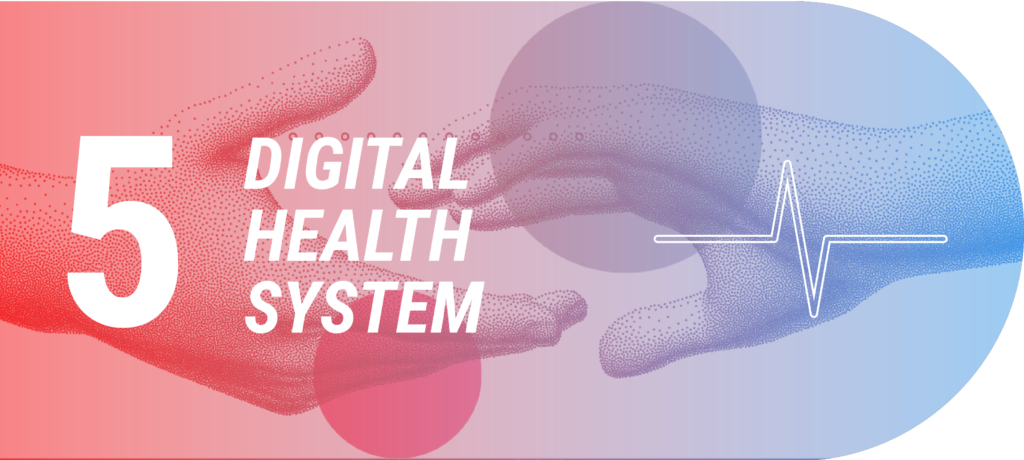
5.1 Platform provider
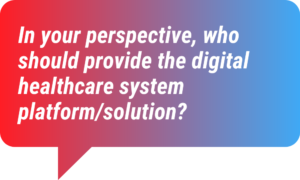
The Swiss healthcare system is highly decentralised and follows a federal structure where the federal government, cantons and local municipalities take on different roles. The system is funded through premiums, taxes, insurance contributions and out-of-pocket payments (Sturny, 2020). The government is responsible for defining the rates of the deductibles and accepts or rejects changes to premiums. Cantons specify which hospitals provide which benefits and specify the working hours and wages of nurses and doctors. The private and public sector must work together. Private health insurance companies provide basic and complementary insurance but they need to follow the regulatory requirements of the Federal Office of Public Health and Financial Market Supervisory Authority (Sanitas). Basic insurance is compulsory for anyone living in Switzerland.
Digitalisation is key to more transparency and easier access to various data. Digital transformation has taken over many industries in Switzerland, making this country very innovative. In the healthcare system, the acceleration of digitalisation would bring various benefits to all the stakeholders, including patients as it would improve health outcomes, treatment quality, patient experience and reduce administrative burden (Hämmerli et al., 2021).
In the survey, we therefore asked Swiss citizens who they believed is the best provider of a Swiss digital healthcare system, defined as a system which enables all health data to be available in an easy-to-use, secure digital way.
More than a quarter of the respondents believe the government (29%) and/or health insurance (27%) should be the provider of a digital healthcare system platform. Hospitals come in third place (20%). NPOs, private organisations² and private-public partnerships³ are only mentioned by a very small percentage (NPOs: 7%, private organisations: 4% and private-public partnerships: 4%).
A high number of interviewees (9%) preferred not to answer this question due to lack of information or lack of opinion.
Swiss citizens strongly believe that the state should play a central role in providing the overall digital solution and believe in the important role of health insurers. In fact, as every citizen has an obligatory insurance, they already have a strong relationship with their insurance provider. Respondents believe that hospitals also have an important role to play but should not be in the driving seat. Private organisations, NPOs and partnerships should only have an indirect role in the system.
It is interesting to see the differences between age groups and the level of education of interviewees. The older or less educated you are, the more you see the hospital as the best provider (65+ yrs: 32%, lower education: 30%). The younger or the more educated you are, the more you believe the government should take responsibility (18-39 yrs: 32%, higher education: 36%).
We can see significant differences between respondents who are very concerned about digitalisation and the ones who are not. The people who are unconcerned believe that the government should be responsible for the platform (35%), whereas the concerned group gives a higher percentage to hospitals (26%). This can be explained by the fact that people who fear digitalisation might want the system to remain as it is and therefore under the control of hospitals.
For now, the government and the health insurance companies have taken up key roles in the digitalisation of the healthcare system. A lot of progress has already been made, but much more needs to be done. Further information on these solutions can be found below. ²Private organisations such as pharmaceutical companies, technological companies etc. ³Private-public partnerships are a cooperation between public authorities and the private sector which provides public sector facilities and services using private resources and expertise (The World Bank, 2022 and Müller-Tschumi & Wyss Ltd, 2012).
Digitalisation of the healthcare system in Switzerland – Background
In 2007, the Federal Government launched the “eHealth Strategy Switzerland” to help patients access and share their health data with selected health providers. The Federal Law on the electronic patient record regulates the secure requirement for handling of health data in the electronic patient record (De Pietro & Francetic, 2018). Since then the adoption has made some progress but it is still rather limited. A revision of the law and consultation in summer 2023 (FOPH, 2022) is planned to ensure its success with changes affecting the voluntary participation and the opt-in model (Hämmerli et al., 2021). Private organisations have developed solutions which comply with the Federal Act on the Electronic Patient Record. In 2022, Swiss Post became the main provider of EPR after acquiring the majority of the shares of Axsana, which was working with the Swisscom solution before successfully migrating to the Swiss Post platform at the beginning of October 2022 (Swiss Post, 2022).
As the government was taking time to implement digital solutions for the healthcare system and the EPR was having a slow start, insurance companies saw the opportunity to launch joint consortiums with other ecosystem players to provide a digital health platform. Two different consortiums have come to life in recent years: Well Gesundheit and Compassana.
Well Gesundheit is a joint venture between CSS, Medi24, Visana, Zur Rose with recent arrival of Galancia, Swiss Medical Network and Allianz Care. It is an open and independent platform connecting what is important in healthcare, treating data securely and confidentially.
Compassana was founded by Medbase, Hirslanden, Groupe Mutuel, Helsana and SWICA to develop a digital healthcare ecosystem. Their goal is to improve treatment quality and process efficiency with the development of a simple, user-friendly portal (Kaufmann, 2022). Even though such solutions are coming into place, one important problem remains, digital technologies cannot currently be reimbursed in Switzerland (Sander et al., 2022).
Digitalisation of the Swiss healthcare system is high on the agenda for many people today. Every player wants to contribute, placing their own piece of the puzzle to enable the full system to be digitalised. The only way to achieve this would be for the public authorities to set the national framework and standards and for all other players to collaborate with one another. The FOPH has recently launched a new expert group focusing on Data management and standardisation (FOPH expert group, 2022).
Graph 11 – Switzerland’s preference for digital healthcare system platform provider
Graph 12 – Swiss citizens desired benefits from digital healthcare system platform
| The electronic patient record as a driver of digitisation in the healthcare sector –Matthias Glück, Swiss Post “Swiss Post firmly believes in the value of the electronic patient record (EPR) as a cornerstone of digital healthcare. The introduction of the EPR means citizens have the key to their health information in their hands. They always have access to their own medical data and can decide for themselves who else also has access to their EPR. Swiss Post is taking a leading role as an integrated provider in the introduction and development of the EPR in Switzerland. Access will also be simplified to ensure that as many people as possible benefit from the EPR. Swiss Post is providing support to interested parties today. They can already seek advice about the EPR in selected Swiss Post branches and open an EPR in person. The goal of all parties involved with the EPR is and will remain that the general public can verify their identity online and open an EPR quickly, simply and electronically in a single step. Service providers such as hospitals and clinics also benefit from the EPR. Patients can grant healthcare professionals easy access to their treatment-related documents. This allows the diagnostic process to be supported digitally. Thus, reducing examination risks, increasing the quality of treatment, and helping control costs in the Swiss healthcare system.” |
5.2 Desired benefits from the platform
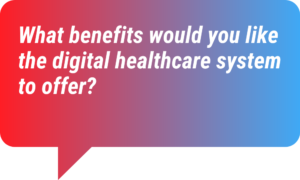
Digital tools have a higher adoption rate when they are user-friendly and offer added value which one would not benefit from without the tool. In most industries nowadays, users play an important role to develop, test and seek feedback on a new tool or device and its key values.
For example, why are people so dependent on their iphones? These devices are easy to use, with clear added value compared to regular phones. Additionally, Apple makes sure to include user feedback in the development of the next generation of smartphones (Vigroux, 2020). This ensures a high retention rate.
Why should this be any different when it comes to the healthcare industry? For now most digital healthcare solutions were developed without asking the main users, the patients, what key benefits they expect the solution to offer.
In this survey we asked the Swiss citizens to choose which three benefits the digital healthcare system should offer?
The most important requirement for the system is the reduction of health costs (cited by 37%). In fact, the healthcare system in Switzerland has extremely high costs (Swiss Confederation – BFS, 2022), which leads to increases in the premiums (Keystone-SDA/dos, 2022). As mentioned in the report from McKinsey & Company, the costs of the Swiss healthcare system could be reduced by CHF 8.2 billion due to digitalisation (Hämmerli et al., 2021).
Swiss citizens highly value having access to their health data from anywhere (31%), at any time (27%) as this would enable them to better monitor their health and play a more active role in their health journey.
Reduction of redundant tasks is also identified as a key benefit (28%). With the analogue healthcare system, it is common for patients to fill out the same information multiple times and to contact different healthcare providers. Having a digital solution which contains all the important health data would be a great time gain as one could easily share the required data with the different health providers. Facilitated communication with the various healthcare providers was also identified as a key value of the system (28%). The respondents would also appreciate having access to additional information about their illnesses and treatment (22%) as this would empower them and raise their health competencies and therefore health literacy.
Swiss citizens see personal ownership of data (13%) and data storage in Switzerland (10%) as less important requirements even though they believe that they should be owning their health data (see section 5.2 – Data ownership).
Engaging with the patient organisations in designing the future improvements of the solution (Hämmerli et al., 2021) of the digital healthcare system and EPR and its roll out will help to include patients’ needs and requirements for digital platforms. This is the only way the whole population will adopt the solution and change their ways of handling their health.
| Added value of universal access to health data (independent of time and space) – Dr. Susanne Weissbäcker, Josselin Meylan, EY-Parthenon “As individuals, our health is based on multiple parameters: 🔹Who we are (our genotype, phenotype…) 🔹How we live (what we eat, how much we move, our environment…) 🔹And how the above expresses itself (our general health status, examination results…) Most of this can be called health data, which is likely to be stored in very different places or systems: Our doctors’ offices, the hospitals we visited, our devices, the claims we file with insurance companies…or even in the results of controlled clinical trials. Combined, these data sets will paint a picture of us what will allow drastic progress in the way we’re treated: 🔹Our conditions can be diagnosed earlier, based on very early signs 🔹For the less fortunate, the right treatment can be identified with less trial and error 🔹Relevant trials can be identified quickly Overall, combining data sets can lead us towards true personalized medicine, with better outcomes at a low marginal cost to society – without even mentioning the cost savings of not duplicating exams because the data hasn’t followed us to our next healthcare provider. To unlock this value, systems designed for privacy and patient consent providing timely access to health data will be key drivers… and only a strong collaboration among all the healthcare system stakeholders will allow this.” |
| Usability and value of an electronic patient record – Thomas Gross, BINT and ofac “The value of the Electronic Patient Record (EPR) is undeniably enormous and indispensable today: We can all store our sensitive health data in a highly secure, federally certified place in Switzerland (and not in a cloud with Google or Apple).Thanks to an equally secure network, we can provide those who are supposed to treat us with access to our data as needed. Our dialogue with them alters fundamentally: We are changing from a rather passive role to an actor on an equal footing. Data from treatment, patient measured data and prevention data join together as a whole. The quality of treatment improves and costs decrease. This EPR is now available, and it basically works. But the usability is not satisfying yet. The onboarding, the identification process, the filling, the integration of structured data from different sources or the networking options with other apps urgently need to be simplified. The FOPH has a particular duty to pave the way for such simplifications. It must not incapacitate users again with exaggerated data protection thinking. If this is heeded, we will be amazed at how much innovation and practical value will be added over time to what is already a remarkable starting point!” |
5.3 Data ownership
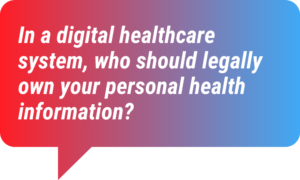
From a legal perspective, ownership is defined as the state of having exclusive rights and control over property (Law, 2022). Property is often thought of as a relation between an individual and an object (Liddell et al., 2021). Personal information was suggested by Alan Westin to be recognised as an object of property rights in the 1960s (Westin, 2015). In this sense, personal health data should be legally owned by patients themselves. Unfortunately, it is not as simple as it seems.
Institutions which collect health data often believe they own the data but in reality they are only “data custodians” and the data is property of the patient. This means that the patient needs to provide consent for the data to be used outside of the clinical institution (Hulsen et al., 2019).
When conducting the survey, we wondered how the Swiss population felt regarding this critical question of data ownership. As expected, more than two thirds of respondents (68%) want to be the legal owners of their personal health information. The electronic patient record (EPR) goes in this direction as the patients themselves have the control over who can access or not their health data in the electronic health record (Swiss Confederation, 2017). Almost one fourth (22%) would like their general practitioner to be the legal owner. The older people are, the more likely they are to want their doctor to have the rights and control their data (65+ yrs: 36%). This could be explained by the fact that the older population trusts their doctor more than themselves to keep track of their health.
The more educated or the more wealthy people are, the more they would like to own their data (high education: 78%, wealthy: 70%). They have access to more information and therefore understand in more depth what it signifies for them to be able to control their own data.
Significant differences can be seen between the different regions of Switzerland. The German-speaking region of Switzerland has a stronger willingness to legally own their health data (71% versus W-CH: 57% and I-CH: 60%), this could be due to the fact that Swiss Germans have a higher trust in individual responsibility which they believe leads to collective responsibility (Bradely, 2020).
Respondents with high digital literacy and health literacy have a stronger desire to personally own their data themselves (very digital literate : 71%, very health literate: 69%). They have higher competencies in both topics and therefore a better understanding of what it entails to own your personal health data.
In the future, patients should be the legal owners of all their health data and therefore have control over their data (able to delete data at any time). Patients should also have control over which data can be taken for secondary use of health data (research) through the patient consent form (swissethics, 2021).
Graph 13 – Perception of Swiss citizens on personal health data legal ownership
| Role of the government in the digital transformation of the health system – Mathias Becher, FOPH “Health care is a collective issue with the citizen as the main stakeholder. The cooperation of all involved players is key to a citizen-centric approach towards a successful digital transformation of the health care system. Given the Swiss federalistic organisation of health care with a number of different participants and parties with varied competencies, the Swiss government’s role is manifold: It guarantees the essential regulatory framework that promotes digitisation and sets the adequate premise for establishing a digital-driven ecosystem in health care, promotes the development of a common architecture and of joint standards, orchestrates the collaboration of all stakeholders within the data ecosystem and provides for the right incentives. Also, the government is to implement its own digital procedures as a part of the common digitised ecosystem, based on the collectively developed architecture.” |
| Role of hospitals in the digital transformation of the health system – Sebastiano Caprara, Balgrist University Hospital “Healthcare systems are currently facing multiple challenges including an ageing population, workforce shortage, and the pressure to perform at highest levels while reducing costs[1]. As a paradigm shift towards electronic health records is rapidly gaining momentum, it is clear that digitalisation has the potential to address these challenges. Data-driven technologies, such as remote patient monitoring devices, risk factors’ prediction, and radiological analysis are developing in mature methods that can support clinical workflow and also potentially the reduction of costs[2]. For a successful clinical translation of these methods, digitalisation is essential but, in addition, it requires effective interlinking of patient records and their interoperability. To optimise the interface between novel technologies and the healthcare system, hospitals should strategically remodel the way digital tools can be integrated into traditional clinical services. A complete integration will be highly effective in terms of improving the patient journey, thus improving population’s trust on digital medical technologies. As trust from the patient is central to successfully developing personalised medicine, and as the majority of patients report the strongest trust in their physicians and medical institutions[3], hospitals must have a central role in the continuous development of digital health solutions. Only in this way will we be able to successfully integrate data-driven technologies in healthcare.” References [1] Bajwa J, Munir U, Nori A, Williams B. Artificial intelligence in healthcare: transforming the practice of medicine. Future Healthcare Journal 2021 Vol 8, No 2: e188–94 [2] Rajkomar A, Oren E, Chen K, Dai A.M. et al. Scalable and accurate deep learning with electronic health records. NPJ Digital Medicine (2018) 1:18[3] Brall C, Berlin C, Zwahlen M, et al. Public preferences towards data management and governance in Swiss biobanks: results from a nationwide survey. BMJ Open 2022; 12: e060844 |
| Role of insurance companies in the digital transformation of the health system – Pius Zängerle, curafutura “Switzerland’s population is proud to have a well established and renowned health system. At the same time, it is a common perception that the grade of digitalisation is average in Switzerland, instead of ranking high as in other sectors of the Swiss economy where Switzerland is world leading. Insurance companies could play the role of a catalyst in the challenge to bring forward the digitalisation, as they have regular contacts to all inhabitants in the country, both patients and insured persons. They are therefore in a dominant role to provide apps and data connected to health and insurance. If insurers successfully bring function to the patients, they can be door openers to digitalisation. From an economic perspective and regarding the relatively small population, it is key that Swiss insurers are supporting solutions where different players – providers and insurers – find ways to establish common platforms (or ecosystems or portals) to achieve minimal size for economic success of digitalisation.” |
| Role of pharmaceutical companies in the digital transformation of the health system – Marie-Jeanne Semnar, Interpharma “In order for an open health data ecosystem to deliver all its potential benefits – for the healthcare system as a whole, as well as for patients and research – all actors involved have their contributions to make. This also applies to the pharmaceutical industry, of course. Pharmaceutical companies are aware of their responsibility: The members of Interpharma are already making valuable contributions that promote the development and setting up of a health data ecosystem. They provide expertise, resources and their international network, invest in the development and maintenance of sub-ecosystems and participate in a variety of collaborations, for example with universities or the government (e.g. private-public partnership). In addition, they train professionals and apprentices in data literacy and share structured data with other researchers and interested parties. In dealing with data, pharmaceutical companies are committed to ethical standards and ask for a clear regulation of secondary use of health data for. To this end, pharmaceutical companies are actively engaged in the societal dialogue about the value of the health data ecosystem.” |
Chapter 6: Trust in Swiss Institutions
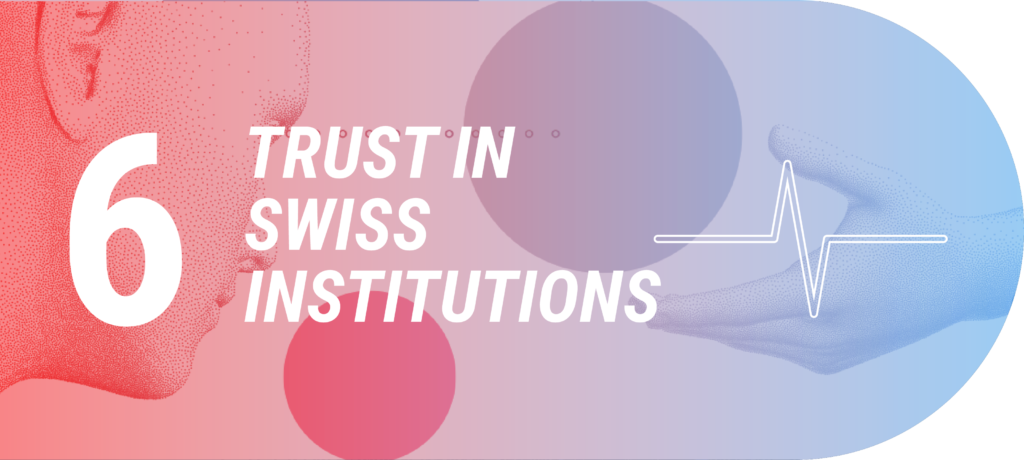
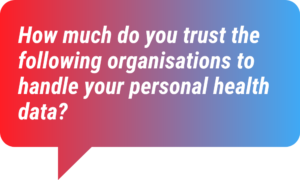
Trust is essential. Nowadays, trust is hard to gain but easily lost. To maintain the trust of its population, Switzerland needs to demonstrate that strict standards are met in regards to the security of data infrastructure. It is an obligation to handle people’s data carefully and communicate transparently with citizens, engaging in a dialogue with the public (Bergamin, 2018). In recent years, Switzerland has observed a massive loss of trust, especially in the middle generation (40 to 64 years old) with a 40% decrease in willingness to store electronic health data between 2018 and 2020 (Golder & Jans, 2020). In the survey, we asked citizens how much they trusted different Swiss institutions (hospitals, public authorities, private organisations and non-for profit organisations) on a scale of 1 to 5 (1= no trust to 5= high trust). In the next sections, you will find a deep dive in the different organisations.
6.1 Trust in health providers (including hospitals)
As shown on Graph 14, 70% of the respondents have a high trust in health providers (scale values 4-5), with the highest value for the older generation stakeholder group (80%). General practitioners are identified as trustworthy partners for data handling (Golder & Jans, 2020). A relationship of trust between healthcare professionals and patients leads to better results in medical treatment. Trust needs to come from both sides with each party knowing their rights and obligations (Swiss Confederation – FOPH, 2022). Older people tend to trust people and institutions more (Knecht & Manz, 2022).
People with high health literacy and high digital literacy have higher trust in hospitals than people without (high health literacy: 74%; high digital literacy: 73%). This is due to the fact that they have more knowledge and understanding and therefore higher expectations in the hospitals which leads to higher trust (Bertram et al., 2021).
6.2 Trust in Public authorities
Despite the COVID-19 pandemic, Switzerland has maintained high faith in the government (Swissinfo, 2021). Almost half of the survey’s respondents (47%) have a high trust in public authocrities (scale values 4-5) (see Graph 15).
More males have a higher trust level in the government than females (54% versus 40%). This is also the case in most OECD⁴ countries as outlined in the Trust Survey 2021 (OECD, 2022).
The younger and more educated respondents are, the higher trust they have in the government (18-39 yrs: 51%; high education: 54%). The young population highly values transparent communication around health topics, which happened for example during the pandemic. This leads to higher trust levels (Gonzálvez-Gallego & Nieto-Torrejón, 2021). Stakeholders who consider their health and digital skills to be high and who are less concerned about digitalisation also have a higher trust in the public authorities (high health competencies: 51%, high digital competencies: 54%, unconcerned about digitalisation: 58%). People with high education, strong digital and/or health skills have a more in depth understanding of the way the public authorities will deal with their health data and this leads to a higher trust than within less educated people. Stakeholders which are less concerned about digitalisation have a higher chance to have faith in how the state will treat their own data. ⁴OECD countries: Organisation for Economic Co-operation and Development is an intergovernmental organisation with 38 countries founded in 1961 to stimulate economic progress and world trade ( https://www.oecd.org).
6.3 Trust in Private sector
The private sector of healthcare combines insurances, pharmaceutical companies, MedTech and BioTech. It encompasses all companies which are not owned or governed by the state but provide health services. Within the survey, they were the sector which Swiss citizens trusted the least. Only one fifth of the respondents have a rather high trust in them (22%). People fear that private companies are working in the healthcare sector solely for their own benefit and not for the benefit of society and that therefore their data will be used only for their personal profit (Gille et al., 2021).
The young generation, as well as the wealthy and upper purchasing power category have the highest trust in the private sector (18-39 yrs: 27%, higher average & wealthy purchasing power: 26%).
6.4 Trust in Non-profit organisation
Non-profit organisations in the healthcare sector include organisations such as WHO⁵, Swiss Red Cross⁶, Doctors Without Borders⁷ and many more. Two fifths of the respondents (40%) have (rather) high confidence in NPOs (scale values 4/5). This correlates with the Edelman Trust Barometer 2022, which shows a raise in trust in multinational institutions such as the WHO (Edelman, 2022).
The young generation has slightly higher trust than older generations once more (18-39 yrs: 45% versus 40-64 yrs: 38% and 65+yrs: 40%). We observe the young generation in Switzerland tends to trust the different health organisations more than the other generations.
Additionally, stakeholders who rate their health and digital skills as high also have greater trust in NPOs than those who consider their skills to be low (high health competencies: 44%, high digital competencies: 45%). People with higher skills have a better understanding of what non-profit organisations are actually pursuing and therefore higher trust in what they would be able to do with their health data.
6.5 Comparison
Health providers (including hospitals) are the most trusted organisation in Switzerland regarding health data handling followed by the government, whereas the private sector is the least trustable sector. Building up trust in different organisations will be key to digitalise the full healthcare system. Health professionals and the government will play a key role in the digitalisation of the healthcare system in Switzerland. Communication will be an important part of the transformation, making sure the population fully understands how their data will be handled and what the added value of such a transformation is. ⁵WHO: United Nations agency which promotes health and keeps the world safe, serving the vulnerable https://www.who.int/) ⁶Swiss Red Cross’ main goal is to maintain, promote and restore good health for everyone (https://www.redcross.ch/en) ⁷Doctors Without Borders brings medical assistance to victims of epidemics, natural disasters, conflict or healthcare exclusion (https://www.msf.org/switzerland)
Graph 14 – Trust in health providers (including hospitals)
Graph 15 – Trust in public authorities
Graph 16 – Trust in private sector
Graph 17 – Trust in non-profit organisation
Chapter 7: Drivers and Barriers to Health Data Sharing
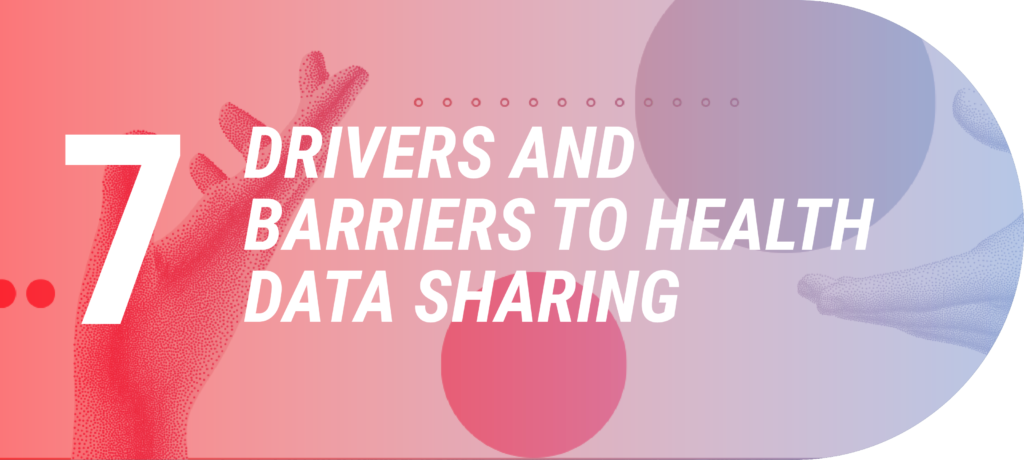
7.1 Actions taken prior to data sharing
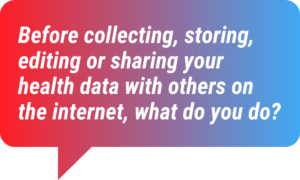
In today’s society people share various types of data with others on different platforms. They often do not check anything prior to sharing and therefore they do not know where their data is stored or processed. It is critical to find a way to let people regain sovereignty over their data and maintain the right of decisions on their data (Fontanet, 2022). This is complex as once the data is shared, it can easily be copied and people can lose control over it. It is therefore important to be attentive to certain criteria before sharing personal data, especially personal health data.
We asked the Swiss population what actions they usually take prior to handling their health data (collecting, storing, editing or sharing). The results can be seen in Graph 18.
Two fifths of respondents (40%) say they want to check who will have access to the data. About a third want to know what the data will be used for (32%) or how it will be protected (31%). Only a few respondents take no action while knowing the consequences (7%).
Another third (31%) do not indicate any clear action, either because they have no experience in this area (15%), because they would never collect, store, process or share health data (14%), or because they did not give a reason for not answering the question (2%).
The older generation has a higher tendency for finding out what will happen to their health data (if they collect/store/edit or share their health data) than the younger generation. This could be explained by the fact that as the respondents are above 65 years, they are more cautious about digitalisation. They are also more attentive to how their data is being processed when they decide to store or share it.
In the future of healthcare, digitalisation will play a key role. It is therefore important to upskill citizens on the value of data and therefore on how to be attentive to the handling of their data. Defining comprehensive guidelines for such data handling would be needed (Hoffmann, 2018). Collecting, storing and sharing data will be regular activities, which need to be taken by everyone but in a smarter way to ensure full control and ownership of the data by its owner.
Graph 18 – Actions taken prior to sharing data
Graph 19 – Conditions to share personal health data
| Added value of health data sharing – Anne Kuruvilla, SwissRe “When sharing or disclosing personal health information, we can feel vulnerable. This stems from a fear of not knowing what is happening with this data and how it is being used. To respond to such legitimate concerns, trust-building measures are needed to explain that stakeholders/providers are pursuing equitable, safe and comprehensive care. The holistic approach is that sharing this data can have many benefits for patients, physicians, hospitals, insurers, etc. For patients, the transparency and deeper insights that data sharing allows means that an emerging condition can be viewed holistically, allowing for better prevention. Doctors and hospitals, on the other hand, have information at their disposal that helps them to take comprehensive and sustainable healing measures. Insurers have the opportunity to make more individual offers or use non-personal data to optimise their risk profiles. Promoting trust among patients is essential. It is important to inform all stakeholders how transparency, security, ownership, and ethical responsibility are defined and guaranteed. A collaborative partnership between data providers, processors and consumers, is therefore mandatory. Such an ecosystem must serve the wellbeing of people and create visible added value for doctors, hospitals, insurers and also for Switzerland. With such advances in digitalisation, the Swiss healthcare system could take an important step forward not only in treatment, but also in efficiency.” |
7.2 Conditions to share personal health data
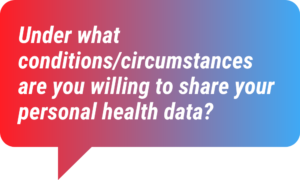
Data sharing in Switzerland begins with the permission/consent of the data owner. It is therefore very important to better understand the drivers and barriers influencing the willingness to share personal health data (Pletscher et al., 2022).
As shown on Graph 19, improved quality of diagnosis/treatment (52%) is the main driver to share data. It is followed in second place by the use of data once anonymised for research purposes (41%). About a third would expect positive effects on health insurance (34%) or other financial benefits (34%). About one in ten respondents (12%) do not find any of these conditions good enough to share their personal health data.
Altruist motivators are the most cited, this is in line with the current healthcare system where the goal of the healthcare system is to heal patients in an optimised way. Secondary use of clinical data for research is very important as it enables us to test new drugs and solutions with real data. Nowadays in Switzerland whenever you visit a hospital or care centre, you are automatically asked for your consent if the centre wants to pursue research or projects using your clinical data. They will ask you if you authorise them to anonymise your data (removing the identifiers⁸) and use it for research (swissethics, 2021). During the COVID-19 pandemic, patients were more willing to share their clinical data to improve research and develop a vaccination in the quickest time possible (Tosoni, 2022). This was the first time in history that researchers had access to so much real time data and collaborated worldwide. This made it possible to develop the first vaccination (Pfizer) in only one year (Solis & Guildford, 2021).
Even if less highly ranked, citizens do also see financial benefits of sharing data. They have a higher incentive to adopt new digital tools when rewarded with financial benefits.
The older generation is willing to share their data mostly to obtain better treatment and diagnostics (62%) and less for any money incentives (21%). This can be explained as they are getting older and this directly impacts their health. They are therefore more sensitive to their wellbeing than to any monetary incentive.
The more educated respondents see higher value for improved treatment (57%) and for research purposes (50%) than others. This was already found in a large-scale survey published in 2021 (Brall et al., 2021). This could be explained by the fact that they have access to more information and knowledge and therefore understand the added value of primary and secondary use of data.
Educational efforts need to be increased in Switzerland to understand and raise awareness of data sharing and the benefits within the population to ensure the patient fully knows how their data is being processed and by whom (O’Connor et al., 2017). If the added value is clearly communicated and understood by the citizens then the adoption of digital tools and mindshift shift to a digital healthcare system should be eased. ⁸Identifier: any feature which clearly identifies an individual and can permit another person to “assume” that individual’s identity.
7.3 Concerns on health data sharing
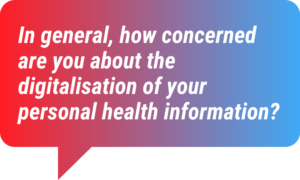
Digitalisation has picked up speed in recent years, especially following the COVID-19 pandemic which also means greater cyber-risks in the healthcare sector. To tackle this, the Swiss Conference of Cantonal Ministers of Public Health developed recommendations on data protection and information security which are based on the National Cyber Security Center recommendations on cybersecurity in healthcare. Cybersecurity is a key factor to ensure resilience and availability of critical health services (Swiss Confederation – NCSC, 2022). To ensure full positive effects of digitalisation in healthcare, it needs to be well protected and maintained.
We wanted to better understand how the Swiss population feels regarding the digitalisation of their personal health information and if they were concerned or not regarding this topic.
A slightly higher percentage of the population is not worried about digitalisation (36% selected scale value 1-2) than very worried about it (31% chose scale value 4-5). This leads to an overall average of 2.9 on a scale of 5 of general concern level (approximately the middle of the scale). The subgroups do not differ significantly from each other.
In the future system, to reduce concerns, we should ensure that digitalisation is well explained to the whole population to avoid inequalities in access to information, and also prioritise data protection to prevent data breaches or cyber attacks. The next section will help us understand in more depth the different fears of the population regarding this digital transformation.
Graph 20 – Concerns related to health data sharing
| How to ensure the security of the digital health system to avoid data breaching? – Garif Yalak, Cisco “Over the past years, healthcare became the #1 target for cybercriminals. Even before the COVID-19 pandemic, 76% of healthcare providers reported they experienced a significant security threat. In its annual trends report, Cisco⁹ found that healthcare was the most targeted industry vertical for the vast majority of the year 2021. Healthcare organisations are particularly susceptible to threats when it comes to IoT. Outside of physical facilities, considerations for healthcare IT and security professionals include medical devices, wearables, telemetry equipment, and a new breed of health apps. Connected medical devices, third-party equipment and systems, and the environment should also be considered. When healthcare organisations define their strategy to strengthen their security posture, our advice is that they structure the thinking around 3 key pillars: people, technology, and processes. From a technology perspective, the most complete and sensible approach is to view security as a whole, treating security as an end-to-end system rather than a distinct set of individual components. Next to technology, the education of employees has the utmost importance. 95% of attacks are successful because of human errors. Industry players such as Cisco offer free education courses in cybersecurity through programs such as the non-profit Cisco Networking Academy.” |
⁹Cisco Talos Incident Response Team
7.4 Fears regarding digitalisation of health data
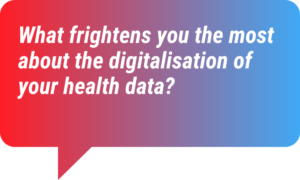
“Everyone has the right to be protected against the misuse of their personal data”, this is a robust privacy right written in the Swiss Constitution (Federal Constitution of the Swiss Confederation, 1999).
Therefore, for the collection and use of sensitive data, such as personal health data, either a legal basis is required, a public interest must be demonstrated, there must be informed consent or the data must be anonymised (DPA, 2011).
In the past years, the media has often drawn attention to the different health data violations, tracing and punishing the data thefts and ensuring to protect the data as best as possible. In 2019, sensitive medical data including 200,000 patient images ended up on unsecured servers. This was due to the fact that this health data was initially stored on servers with poor security (Keystone-SDA/AFP/ts, 2019). It is very important to store health data on servers which are protected and well maintained. One other important data breach took place in early 2021 when Myvaccines foundation was suspected of violating data protection. The free platform allowed people to create an electronic version of their paper vaccination record to ensure regular updates on their vaccination status. It was supported by the Swiss Government. The platform was accused of making 450,000 vaccination data information of 240,000 people openly accessible and vulnerable to manipulation. This led to the Federal Data Protection Act opening a procedure against Myvaccins in accordance with the Federal Data Protection and Information Commissioner (FDPIC) and National Cyber Security Centre (NCSC) (Keystone-SDA/ac, 2021).
These extreme examples, even if rather rare, tend to scare the Swiss citizens regarding digitalisation of their health data as they are afraid that their health data will be mishandled or misstored.
In the survey, we wanted to get a better sense of what the Swiss citizens fear about the digitalisation of their health information.
As illustrated in Graph 21, almost half of the respondents fear misuse or theft of their data (46%). The second most important reason (38%), is the fear of data misuse due to incorrect or improper storage. In third position, the population is frightened by the fact that a third party will make money with their health data (29%). This is closely followed by the fear of being controlled (26%).
A fifth of the respondents are afraid of their health data negatively impacting their insurance (22%), losing control over their data (21%) or fearing to lose access to medical data (17%).
One in ten do not have any fears regarding digitalisation (9%).
As expected, the stakeholders who are very concerned about digitalisation are more afraid of the fact of being controlled (36%).
Data protection needs to be at the centre of the future digitalisation of the healthcare system, ensuring appropriate systems and servers are used to store and share data and avoid any data mishandling, misstoring or data theft. Additionally, it should be ensured that patients are fully responsible for and in full control of their own health data and that third parties not have access to the data without the patient’s consent.
Graph 21 – Fears regarding digitalisation of health data
Conclusion
The survey reveals that the Swiss population is willing to use a digital healthcare system if it offers clear added value for the citizens, such as better usability, improved diagnosis and treatments, as well as reduced healthcare costs.
Swiss citizens have high levels of literacy in digitalisation and health but more can be done in order to ensure that no one is left behind. A stronger focus should be set on empowering citizens to better navigate their health and engage with the digital world. Digitalisation opens up a whole new source of knowledge where patients can search for information and become agents of their own health and have more control over their health.
It is also very important to upskill the population to better understand how their data is being processed as well as to show them the direct societal benefits of data sharing. Today, the Swiss population is primarily concerned about data mishandling, data theft and third parties making money from their data. To reassure citizens, data protection should be at the heart of the digital solution to ensure that appropriate systems and servers are used to store health data.
Swiss citizens already use digital devices on a daily basis for work and leisure. Additionally, applications and wearables are already regularly used in Switzerland to track health data.
Citizens could therefore easily learn how to use these tools to monitor their health and wellbeing. This information would help them make positive decisions regarding their life, take on healthier habits and prevent them from many illnesses. This real-time data would also be a key asset for health professionals to better diagnose and treat patients.
These devices need to be tailored to be used by all,whatever their age, education, or gender. We are all “patients” at the end of the day as we are all daily affected by our health. We, as patients, should be invited to co-design the future of the digital healthcare system and EPR. This would ensure a higher adoption rate as the solution would be patient-centric and answer the needs of citizens: reducing health costs, easier access to health data independent of time and space and time reduction spent on admin tasks.
Citizens should be the legal owners of their health data as outlined by most survey respondents. They want to have full control over their health information and how it is being used. We are moving from a system where hospitals are at the centre towards a system where the patient is at the centre.
The question of trust is also crucial. Hospitals, followed by the government are considered the most trusted organisations in Switzerland when it comes to handling health data. Building trust in the different health organisations will be important for this digital transformation, as all players contribute to this transformation to enable the system to be digitalised from end to end. This will only be feasible if public authorities set a national framework with key standards and for all actors to collaborate. Increased adoption of the digital system and a change in the public’s mindset are only possible if all efforts are directed towards clearly communicating how the system will work, how health data will be digitally processed and what key benefits citizens will have in their daily lives.
We hope that with our Digital Health initiative we can contribute to the overarching goal of digitalising the entire healthcare system and making it patient centric by aligning all healthcare stakeholders and empowering citizens.
About the Authors
This document was written between mid-October and mid-November 2022 based on the results from the Swiss population’s survey: “Needs and fears of the citizens towards the digitalisation of the healthcare system in Switzerland”. The survey was conducted in partnership with gfs-zurich.
Main author:
Jade Sternberg, Senior Project Lead Digital Health, digitalswitzerland
Support from the Digital Health Steering Committee from digitalswitzerland:
Mathias Becher, Head of Digital Transformation department (CDO), Federal Office of Public Health (FOPH)
Dr. Sebastiano Caprara, Health Data Repository Project Lead, Balgrist Hospital
Philomena Colatrella, CEO, CSS
Susanne Gedamke, Director, Swiss Patient Organisation (SPO)
Alexandros Giannakis, Managing Director – Global Lead Life Sciences Digital Health Accenture
Matthias Glück, Head of Platform Ecosystems, Swiss Post Digital Health
Thomas Gross, Strategic advisor, BINT and ofac group
Anna Kuruvilla, Head of Tech Steering & Innovation Management, SwissRe
Toni La Rosa Group Chief Sales Officer, ELCA
Dr. med Conrad Eric Müller, President Pro UKBB Foundation, Paediatric surgeonMarie-Jeanne Semnar, Public Policy Manager, Interpharma
Dr. Susanne Weissbäcker, Partner at EY-Parthenon Life Sciences Strategy
Dr. Garif Yalak, Head of Digital Transformation Healthcare, Education & Governance, Country, Digital Acceleration, Cisco Switzerland
Pius Zängerle, Director, curafutura
About digitalswitzerland
digitalswitzerland is a nationwide, cross-sector initiative that aims to strengthen Switzerland’s position as a leading digital nation. Under the umbrella of digitalswitzerland more than 240 organisations, consisting of association members and politically neutral foundation partners, are working together to achieve this goal. digitalswitzerland is the point of contact for all questions relating to digitalisation and is committed to solving a wide range of challenges. Learn more about digitalswitzerland.
We would like to thank Karin Mändli Lerch and her team at gfs-zürich for their support in conducting the survey.
About Digital Health initiative and its Steering Committee
In 2022, digitalswitzerland launched a new initiative in Digital Health which aims to digitalise the entire healthcare system in Switzerland and make it patient-centric. This will help increase transparency, accessibility and understanding of health information for the entire Swiss population. All healthcare actors need to collaborate to achieve this ambitious goal.
digitalswitzerland built up a Steering Committee composed of experts from different sectors of the Swiss healthcare sector who help drive and shape the future of Digital Health in Switzerland.
We would like to thank all of the Digital Health Steering Committee members for their engagement, their support in the study and expert contribution text.
Question glossary
Chapter 1: Health status
1.1 Do you feel sufficiently informed about your state of health?
1.2 From which actors would you like to obtain additional information regarding general health prevention activities in Switzerland?
1.3 How would you personally report your current health status?
Chapter 2: The Patient
2.1 Who do you consider to be a “patient”?
2.2 Are you currently suffering from a chronic disease?
(e.g. arthritis, asthma, cancer, chronic heart disease, chronic kidney disease, Crohn’s disease, diabetes, epilepsy, high/low blood pressure, Lyme disease, obesity, etc. )
Chapter 3: Health and Digital Literacy in Switzerland
3.1 How health literate are you?
3.2 How digitally literate are you?
Chapter 4: Digital Habits
4.1 How many hours a day do you spend on a digital device (including time spent at work) ? Devices such as tablets, computers, smartphones etc.
4.2 What personal health data do you receive and/or manage digitally via apps, on websites or in portals?
4.3 Do you use apps or gadgets (such as FitBit, Apple Watch or cycle tracking apps) to monitor your health?
Chapter 5: Digital Health system
5.1 In your perspective, who should provide the digital healthcare system platform/solution?
5.2 What benefits would you like the digital healthcare system to offer?
5.3 In a digital healthcare system, who should legally own your personal health information?
Chapter 6: Trust in Swiss institutions
How much do you trust the following organisations to handle your personal health data?
Chapter 7: Drivers and barriers to health data sharing
7.1 Before collecting, storing, editing or sharing your health data with others on the internet, what do you do?
7.2 Under what conditions/circumstances are you willing to share your personal health data?
7.3 In general, how concerned are you about the digitalisation of your personal health information?
7.4 What frightens you the most about the digitalisation of your health data?
References
- About Chronic Diseases. (n.d.). CDC. Retrieved October 20, 2022, from https://www.cdc.gov/chronicdisease/about/index.htm
- ALA. (2011). What is Digital Literacy? ALA Institutional Repository. https://alair.ala.org/handle/11213/16260
- Bergamin, F. (2018, March 26). “Trust is essential” | ETH Zurich. ETH Zürich. Retrieved November 3, 2022, from https://ethz.ch/en/news-and-events/eth-news/news/2018/03/interview-vayena.html
- Bertram, M., Brandt, U. S., Hansen, R. K., & Svendsen, G. T. (2021, September 16). Does higher health literacy lead to higher trust in public hospitals? – International Journal for Equity in Health. International Journal for Equity in Health. Retrieved November 3, 2022, from https://equityhealthj.biomedcentral.com/articles/10.1186/s12939-021-01528-w
- Björnberg, A., & Phang, A. Y. (2019). Euro Health Consumer Index: 2018. Health Consumer Powerhouse.
- Bradely, S. (2020, March 29). How the Covid-19 crisis reveals cultural divide between Swiss language regions. Swissinfo. Retrieved November 3, 2022, from https://www.swissinfo.ch/eng/society/covid-19-impact_how-the-crisis-reveals-cultural-divide-between-swiss-language-regions/45647692
- Brall, C., Berlin, C., Zwahlen, M., Ormond, K. E., Egger, M., & Vayena, E. (2021, April 1). Public willingness to participate in personalized health research and biobanking: A large-scale Swiss survey. PLOS. Retrieved November 8, 2022, from https://journals.plos.org/plosone/article?id=10.1371/journal.pone.0249141
- Compassana. The digitally supported health ecosystem. Compassana. Retrieved November 1, 2022, from https://www.compassana.ch/en
- Compulsory schooling – SWI swissinfo.ch. (2022, September 22). Swissinfo. Retrieved October 24, 2022, from https://www.swissinfo.ch/eng/compulsory-schooling/29286538
- CSS. active365 – the app that rewards you from CSS. CSS. Retrieved 2022, from https://www.css.ch/en/private-customers/my-health/active365.html
- Deber, R. (2005). Patient, consumer, client, or customer: what do people want to be called? Health Expect, (4):345-51. doi: 10.1111/j.1369-7625.2005.00352.x. PMID: 16266422; PMCID: PMC5060307.
- De Gani, S. M., Jaks, R., Bieri, U., & Kocher, J. P. (2021). Health Literacy Survey Schweiz 2019-21. Schlussbericht im Auftrag des Bundesamtes für Gesundheit BAG. Zürich. Careum Stiftung.
- De Pietro, C., & Francetic, I. (2018). E-health in Switzerland: The laborious adoption of the federal law on electronic health records (EHR) and health information exchange (HIE) networks. SciencesDirect, Health Policy 122 (2018) 69-74. 10.1016/j.healthpol.2017.11.005
- digitalswitzerland. Making Switzerland a leading digital innovation hub. Retrieved November 14, 2022, from https://digitalswitzerland.com/
- DPA. (2011). Federal Act on Data Protection (DPA) of 19 June 1992 (status as of 1 January 2011), RS 235.1.
- Edelman. (2022). 2022 Edelman Trust Barometer. Global Report Edelman. Retrieved November 7, 2022, from https://www.edelman.com/trust/2022-trust-barometer
- Elnagar, A., Alnazzawi, N., Afyouni, I., Shahin, I., Nassif, A., & Salloum, S. A. (2022). Prediction of the intention to use a smartwatch: A comparative approach using machine learning and partial least squares structural equation modeling. ScienceDirect, Volume 29. https://doi.org/10.1016/j.imu.2022.100913
- Federal Constitution of the Swiss Confederation. (1999). Art. 13 right to privacy 1. Every person has the right to privacy in their private and family life and in their home, and in relation to their mail and telecommunications.2 every person has the right to be protected against the misuse of their personal dat [Federal Constitution of the Swiss Confederation of 18 April 1999 (status as of 3 march 2013), RS 101.].
- Fontanet, M. (2022). THE SWISS DATA CUSTODIAN, PART 2: HOW TO ENHANCE BOTH DATA SHARING AND DATA PRIVACY. Swiss Data Science Center. Retrieved November 8, 2022, from https://datascience.ch/the-swiss-data-custodian-part-2-how-to-enhance-both-data-sharing-and-data-privacy/
- FOPH. (2022, June 24). Développement du dossier électronique du patient. BAG. Retrieved November 1, 2022, from https://www.bag.admin.ch/bag/fr/home/strategie-und-politik/nationale-gesundheitsstrategien/strategie-ehealth-schweiz/umsetzung-vollzug/weiterentwicklung-epd.html
- FOPH expert group. (2022, September 20). Transformation numérique du système de santé : première séance du groupe spécialisé Gestion des données. BAG. Retrieved November 28, 2022, from https://www.bag.admin.ch/bag/fr/home/das-bag/aktuell/medienmitteilungen.msg-id-90422.html
- Gille, F., Smith, S., & Mays, N. (2021). What is public trust in the healthcare system? A new conceptual framework developed from qualitative data in England. ETH Zurich publications – Social Theory & Health 19. https://doi.org/10.1057/s41285-020-00129-x
- Golder, L., & Jans, C. (2020). Swiss eHealth Barometer 2020 Bericht zur Bevölkerungsbefragung. gfs.bern, 15.
- Gonzálvez-Gallego, N., & Nieto-Torrejón, L. (2021, January 6). Can open data increase younger generations’ trust in democratic institutions? A study in the European Union. PLOS. Retrieved November 3, 2022, from https://journals.plos.org/plosone/article?id=10.1371/journal.pone.0244994
- Guggiari, E., Jaks, R., Berger, F. M. P., Nicca, D., & De Gani, S. M. (2021). Health Literacy in the Canton of Zurich: First Results of a Representative Study. International Journal of Environmental Research and Public Health.
- Hämmerli, M., Müller, T., Biesdorf, S., Ramezani, S., Sartori, V., Steinmann, M., van der Veken, L., Fleisch, E., & von Wangenheim, F. (2021). Digitization in healthcare: the CHF 8.2 billion opportunity for Switzerland | Switzerland. McKinsey. Retrieved November 1, 2022, from https://www.mckinsey.com/ch/our-insights/digitization-in-healthcare
- Health insurance. BAG. Retrieved October 21, 2022, from https://www.bag.admin.ch/bag/en/home/versicherungen/krankenversicherung.html
- Heath, S. (2022). Digital Health Literacy: Why It’s Important and How to Improve It. PatientEngagementHIT. https://patientengagementhit.com/features/digital-health-literacy-why-its-important-and-how-to-improve-it
- Helsana. Helsana +. Helsana + app. Retrieved 2022, from https://www.helsana.ch/de/private/services/apps/helsana-plus.html?utm_source=google&utm_medium=gsn&utm_campaign=2022_01_sea_plus_app_01&utm_term=de_all_rsa&utm_content=plus_app&gclid=CjwKCAjw79iaBhAJEiwAPYwoCIBy-kH8LfVBfX75NU5SFwSw3cN8C7hc-Y3rQCDbUvoHAvLz9
- Hoffmann, C. (2018, May 8). Getting health data sharing off the ground. ETH Zürich. Retrieved November 8, 2022, from https://ethz.ch/en/news-and-events/eth-news/news/2018/05/getting-health-data-sharing-off-the-ground.html
- HRSA. (2022). Health Literacy. HRSA. Retrieved 2022, from https://www.hrsa.gov/about/organization/bureaus/ohe/health-literacy
- Hulsen, T., Jamuar, S. S., Moody, A. R., Karnes, J. H., Varga, O., Hedensted, S., Spreafico, R., Hafler, D. A., & McKinney, E. F. (2019). From Big Data to Precision Medicine. Frontiers in Medicine, 10.3389/fmed.2019.00034.
- IMD World Competitiveness Center. (2022). World Competitiveness Rankings – IMD. IMD Business School. Retrieved November 11, 2022, from https://www.imd.org/centers/world-competitiveness-center/rankings/world-competitiveness/
- Institute of Medicine. (1994). Defining Primary Care: An Interim Report. In DC: The National Academies Press. https://doi.org/10.17226/9153.
- Kaufmann, D. C. (2022, January 27). Medbase, Hirslanden, Groupe Mutuel, Helsana, and SWICA launch a joint healthcare ecosystem | Hirslanden. Hirslanden Group. Retrieved November 1, 2022, from https://www.hirslanden.ch/en/corporate/media-news/press-releases/compassana-healthcare-ecosystem.html
- Kemp, S. (2022). Digital 2022: Switzerland — DataReportal – Global Digital Insights. DataReportal. https://datareportal.com/reports/digital-2022-switzerland
- Keystone-SDA/ac. (2021, March 23). Swiss online vaccine registry probed for data security issues. Swissinfo. Retrieved November 8, 2022, from https://www.swissinfo.ch/eng/politics/swiss-online-vaccine-registry-probed-for-data-security-issues/46471504
- Keystone-SDA/AFP/ts. (2019, September 17). Swiss patient data left unprotected online – SWI swissinfo.ch. Swissinfo. Retrieved November 8, 2022, from https://www.swissinfo.ch/eng/data-protection_swiss-patient-data-left-unprotected-online/45235374
- Keystone-SDA/dos. (2022, September 27). Health insurance premiums to take biggest jump in a decade. Swissinfo. Retrieved November 1, 2022, from https://www.swissinfo.ch/eng/health-insurance-premiums-set-for-biggest-jump-in-a-decade/47933914
- Kim, S., Lee, B., Park, M., Oh, S., Chin, H., & Koo, H. (2016). Prevalence of chronic disease and its controlled status according to income level. Medicine (Baltimore), 95(44):e5286. 10.1097/MD.0000000000005286. PMID: 27858900; PMCID: PMC5591148.
- Knecht, R., & Manz, B. (2022, May 31). Which Professionals Do Swiss Trust the Most? Moneyland.ch. Retrieved November 3, 2022, from https://www.moneyland.ch/en/swiss-trust-survey-2022
- Koch, L. (2018, December 18). What’s Driving Wearables Adoption Among Millennials? – eMarketer Trends, Forecasts & Statistics. Insider Intelligence. Retrieved October 31, 2022, from https://www.insiderintelligence.com/content/the-wearables-series-millennials-infographic
- LAMal. (1994). RS 832.10 – Loi fédérale du 18 mars 1994 sur l’assurance-maladie (LAMal/KVG). Fedlex Federal law. https://www.fedlex.admin.ch/eli/cc/1995/1328_1328_1328/fr
- Law, J. (Ed.). (2022). A Dictionary of Law. Oxford University Press.
- Liddell, K., Simon, D. A., & Lucassen, A. (2021). Patient data ownership: who owns your health? Journal of Law and the Biosciences, Volume 8(Issue 2). https://doi.org/10.1093/jlb/lsab023
- Müller, O. R. (2022, March 8). State of the Industry – Swiss Watchmaking in 2022. SJX Watches. Retrieved October 31, 2022, from https://watchesbysjx.com/2022/03/morgan-stanley-watch-industry-report-2022.html
- Müller-Tschumi, T., & Wyss Ltd, W. (2012). Contractual framework of infrastructure PPPs under Swiss law. Thomsons Reuters – Practical law. Retrieved November 1, 2022, from https://content.next.westlaw.com/8-519-2090?__lrTS=20220212180755092&transitionType=Default&contextData=(sc.Default)&firstPage=true
- Neuberger, J. (1999). Let’s do away with “patients”. BMJ, 318(7200), 1756-1758.
- O’Connor, Y., Rowan, W., Lynch, L., & Heavin, C. (2017). Privacy by Design: Informed Consent and Internet of Things for Smart Health. Procedia Computer Science, Volume 113, 653-658. https://doi.org/10.1016/j.procs.2017.08.329.
- O’Dea, S. (2020, April 20). Switzerland: smartphone user penetration 2018-2024. Statista. Retrieved October 28, 2022, from https://www.statista.com/statistics/568277/predicted-smartphone-user-penetration-rate-in-switzerland/
- OECD. (2022). Building Trust to Reinforce Democracy: Main Findings from the 2021 OECD Survey on Drivers of Trust in Public Institutions. Building Trust in Public Institutions, OECD Publishing Paris. https://doi.org/10.1787/b407f99c-en.
- Pletscher, F., Lerch, K. M., & Glinz, D. (2022, June 16). Willingness to share anonymised routinely collected clinical health data in Switzerland: a cross-sectional survey. Swiss Medical Weekly. Retrieved November 8, 2022, from https://smw.ch/article/doi/smw.2022.w30182
- Prasad, S., Sung, B., & Aggarwal, B. (2012). Age-associated chronic diseases require age-old medicine: role of chronic inflammation. Prev Med., (54 Suppl(Suppl):S29-37.). doi: 10.1016/j.ypmed.2011.11.011. Epub 2011 Dec 9. PMID: 22178471; PMCID: PMC3340492.
- Press, G. (2015). A Very Short History of Digitization. https://www.forbes.com/sites/gilpress/2015/12/27/a-very-short-history-of-digitization/?sh=13a5fc5e49ac
- Robert, B. Digital transformation in education: Switzerland is a leader. Hospitality News & Business Insights by EHL. Retrieved October 26, 2022, from https://hospitalityinsights.ehl.edu/digital-transformation-switzerland
- Rubín, M. A., Yang, X., Fenazzi, S., & Uda, K. (2020). The generational digital divide climbs to age 80 – SWI swissinfo.ch. Swissinfo. https://www.swissinfo.ch/eng/society/the-generational-digital-divide-climbs-to-age-80/46198012
- Sander, J., Jeandupeux, M., & Barriscale, M. (2022, 10 31). How to develop and commercialise digital health solutions. PWC publications.
- Sanitas. Swiss healthcare system | Sanitas health insurance. Retrieved November 1, 2022, from https://www.sanitas.com/en/private-customers/life-events/immigrating-or-emigrating/new-to-switzerland/swiss-healthcare-system.html
- Schoonbee, J. (2021, February 1). How lifestyle data can help us personalise the insurance industry. ITIJ. Retrieved October 31, 2022, from https://www.itij.com/latest/news/how-lifestyle-data-can-help-us-personalise-insurance-industry
- Solis, J., & Guildford, A. (2021, November 13). COVID-19 vaccine: How was it developed so fast? Medical News Today. Retrieved November 8, 2022, from https://www.medicalnewstoday.com/articles/how-did-we-develop-a-covid-19-vaccine-so-quickly
- sproutsocial. How Different Generations Use Social Media [2021 Stats]. Sprout Social. Retrieved October 31, 2022, from https://sproutsocial.com/insights/guides/social-media-use-by-generation/#how-millennials-use-social-media
- Sturny, I. (2020, June 5). Switzerland. Commonwealth Fund. Retrieved November 1, 2022, from https://www.commonwealthfund.org/international-health-policy-center/countries/switzerland
- Swiss Confederation. Preparing for retirement in Switzerland. ch.ch. Retrieved October 28, 2022, from https://www.ch.ch/en/retirement/preparing-for-retirement/#retiring-at-the-statutory-retirement-age
- Swiss Confederation. (2017). RS 816.11 – Ordonnance du 22 mars 2017 sur le dossier électronique du patient (ODEP). Fedlex. Retrieved November 3, 2022, from https://www.fedlex.admin.ch/eli/cc/2017/204/fr
- Swiss Confederation – BFS. (2021). MONET 2030: Digital skills | Federal Statistical Office. Retrieved October 26, 2022, from https://www.bfs.admin.ch/bfs/en/home/statistics/sustainable-development/monet-2030/all-indicators/4-eduction/digital-competencies.html
- Swiss Confederation – BFS. (2022). Health care costs and financing in 2020: provisional data | Federal Statistical Office. Retrieved October, 2022, from https://www.bfs.admin.ch/news/en/2022-0099
- Swiss Confederation – FOPH. (2022, June 2). Patients’ rights. Bundesamt für Gesundheit BAG. Retrieved November 3, 2022, from https://www.bag.admin.ch/bag/en/home/medizin-und-forschung/patientenrechte.html
- Swiss Confederation – NCSC. (2022, July 28). Recommendations on cybersecurity in the healthcare sector. Retrieved November 8, 2022, from https://www.ncsc.admin.ch/ncsc/en/home/aktuell/im-fokus/2022/empfehlungen-gesundheitssektor.html
- swissethics. (2021). Patient information and Declaration of consent. swissethics. Retrieved November 3, 2022, from https://swissethics.ch/en/templates/studieninformationen-und-einwilligungen
- Swissinfo. (2018, June 6). 50% of adults in Switzerland use ‘lifelogging’ applications – SWI swissinfo.ch. Swissinfo. Retrieved October 31, 2022, from https://www.swissinfo.ch/eng/business/health-trends_50–of-adults-in-switzerland-use–lifelogging–applications/44171744
- Swissinfo. (2019, August 26). Young Swiss spend on average four hours a day online. Swissinfo. Retrieved October 28, 2022, from https://www.swissinfo.ch/eng/society/online-habits_young-swiss-develop-coping-strategies-for-internet-use/45185268?utm_campaign=teaser-in-article&utm_medium=display&utm_source=swissinfoch&utm_content=o
- Swissinfo. (2021, June 22). Sense of security and trust remains high in Switzerland. Swissinfo. Retrieved November 3, 2022, from https://www.swissinfo.ch/eng/society/sense-of-security-and-trust-remains-high-in-switzerland/46725782
- Swiss Post. (2022, August 9). Swiss Post plans to acquire a majority shareholding in Axsana | Swiss Post. Die Post. Retrieved November 1, 2022, from https://www.post.ch/en/about-us/media/press-releases/2022/swiss-post-plans-to-acquire-a-majority-shareholding-in-axsana
- Tosoni, S. (2022, May 20). Patient consent preferences on sharing personal health information during the COVID-19 pandemic: “the more informed we are, the more likely we are to help” – BMC Medical Ethics. BMC Medical Ethics. Retrieved November 8, 2022, from https://bmcmedethics.biomedcentral.com/articles/10.1186/s12910-022-00790-z
- UNECE. (2020). Gross domestic product (GDP) per capita – Data Portal – United Nations Economic Commission for Europe. UNECE Data Portal. https://w3.unece.org/PXWeb/en/CountryRanking?IndicatorCode=12
- Vigroux, P. (2020, August 11). How Customer Feedback Surveys helps Apple. Skeepers. Retrieved November 3, 2022, from https://skeepers.io/en/blog/how-customer-feedback-surveys-helps-apple-maintains-industry-leadership/
- Ward, M. M. (2013). Sense of control and self-reported health in a population-based sample of older Americans: assessment of potential confounding by affect, personality, and social support. Int J Behav Med., 20(1):140-7. 10.1007/s12529-011-9218-x. PMID: 22282403; PMCID: PMC3521845.
- Well Gesundheit. The new health platform. Well. Retrieved November 1, 2022, from https://www.well.ch/en/
- Westin, A. F. (2015). Privacy and Freedom. Ig Publishing.
- The World Bank. About PPPLRC and PPPs | Public Private Partnership. PPPLRC. Retrieved November 1, 2022, from https://ppp.worldbank.org/public-private-partnership/about-us/about-public-private-partnerships
- World Health Organization. (2017, February 3). Determinants of health. World Health Organization (WHO). https://www.who.int/news-room/questions-and-answers/item/determinants-of-health
- World Health Organization. (2022). World health statistics 2022: monitoring health for the SDGs, sustainable development goals. Geneva: World Health Organization. Licence: CC BY-NC-SA 3.0 IGO.
- Worldometer. Switzerland Population (2022). Worldometer. Retrieved October 28, 2022, from https://www.worldometers.info/world-population/switzerland-population/
Impressum
The Swiss population’s perspective on the digitalisation of the healthcare system in Switzerland
Zurich, 14 December 2022
Although great care has been taken in the preparation of this publication, the author and contributors involved are not responsible for the accuracy of the data, information and advice provided, nor for any printing errors.
All rights reserved, including translation into other languages. No part of this publication may be reproduced, transcribed and/or translated into any computer language, including any information processing language, in any form without the prior written permission of the authors.
The rights to the trademarks mentioned remain with their respective owners.
Coordination of the publication: Emily Livingston, Eliane Panek and Jade Sternberg (digitalswitzerland)
Graphic design: Lina Alice Machts (Ads and Ventures)
In this text, we refer to health data as any information related to the physical or mental health of an individual or the provision of health services to the individual. It refers to any type of data related to health status, personal choice of treatment, health security or policy number, all types of treatment reports, causes of death, socio-economic parameters regarding health and wellbeing, historical health data such as diseases in past years and this kind of information (IGI Global – 2019).